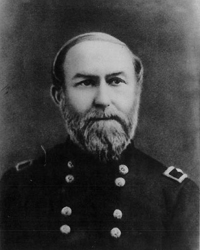Lieutenant Colonel
Charles B. Kingsbury
 Following
his graduation from the United States Military Academy on 1 July 1840, Lt. Col. Charles Kingsbury began a 30 year
career in the Army. In 1845 Kingsbury distinguished himself by becoming the first Ordnance officer to accompany
the Army in the field during the Mexican-American War. In August 1845, he was directed to report to General
Taylor, the commander of the Army of Occupation at Corpus Christi, TX. His orders were received at Washington, DC
at 10 AM and by 9 PM that night; he was steaming down the Potomac on his way to the Gulf of Mexico.
Following
his graduation from the United States Military Academy on 1 July 1840, Lt. Col. Charles Kingsbury began a 30 year
career in the Army. In 1845 Kingsbury distinguished himself by becoming the first Ordnance officer to accompany
the Army in the field during the Mexican-American War. In August 1845, he was directed to report to General
Taylor, the commander of the Army of Occupation at Corpus Christi, TX. His orders were received at Washington, DC
at 10 AM and by 9 PM that night; he was steaming down the Potomac on his way to the Gulf of Mexico.
After organizing his department at Corpus Christi and establishing a supply depot on St. Joseph Island, he was then transferred to Galveston. His assignment at Galveston was to forward artillery and ammunition to Point Isabel to meet with General Taylor's army when it arrived at the Rio Grande. He next reported to General Wool as the Chief of Ordnance to the Army. He spent six weeks at San Antonio preparing the ordnance supply train for the long and arduous march through an unknown and hostile country. On the way he discovered two pieces of field artillery that formerly belonged to Mexico. As they were of a peculiar caliber, it was necessary to improvise new ammunition to make them useful. These two guns went on to provide valuable services at the Battle of Buena Vista.
As a Captain, Kingsbury was serving as the Principal Assistant in the Ordnance Office when word was received that Virginia had seceded from the Union and Governor Letcher was about to send an armed force to capture Harper's Ferry Arsenal and about fifteen thousand muskets and rifles for use by the rebellion. The Secretary of War immediately ordered Kingsbury to the command of the arsenal. It soon became evident that any attempt to defend the post with the few regulars on hand would fail. The only alternative was to destroy the arms stored there to prevent them from falling into the hands of Confederate sympathizers. Since the peril was imminent, there was no time for deliberation or discussion. With a full sense of the responsibility he incurred, he determined to destroy, if possible, the armory and its contents. When the report came that Letcher's raiders were within three miles of the armory, the order was given to apply the match. Although some shops and machinery fell into the hands of the enemy, the arms for which the expedition was principally undertakes were destroyed and the first rebel enterprise of Virginia was defeated.
The destruction of the arms at Harper's Ferry was probably much more important of an event than was supposed at the time. The facts seem to indicate beyond an doubt that the object of the raid was to capture the arms and proceed at once to Baltimore, arm the ruffians and traitors then having supremacy in the city and make an easy conquest of Washington. If that night at Harper's Ferry saved the capital, it may have well as saved the nation. If the seat of government had fallen to the rebels, France and England may well have given the recognition that the Confederacy needed to win the war.
When Congress established Rock Island Arsenal on 11 July 1862, Kingsbury was appointed as a member of the Board of Officers to determine the best site for the principal building. He was also assigned to oversee construction and command the arsenal. He was at once impressed with the military capabilities of the location. Foreseeing that a national; armory and manufacturing facility would be required to meet the needs of the Mississippi Valley, he soon urged that the United States acquire the entire island. Much of the manufacturing, railroad and waterpower companies were attempting to lease or purchase the island before and during the government's interest in the location.